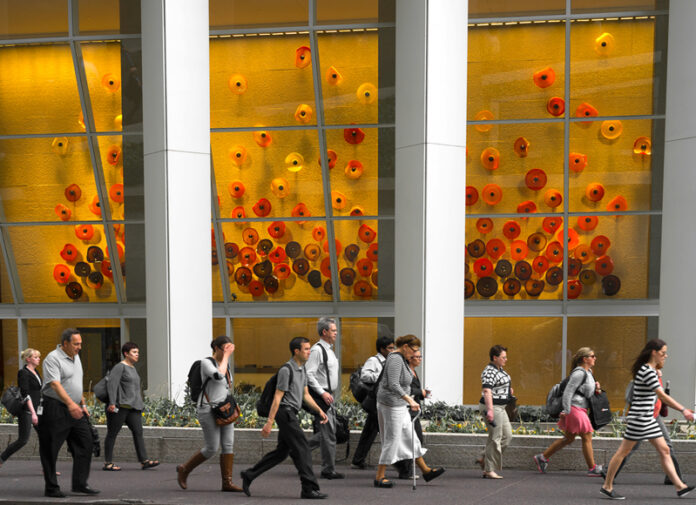By
Bill Hedrick
Life in Kerrville, Texas, is a bit more laid back than it is in some other parts of the state and folks don’t seem to be in as big of a rush to get somewhere as they do in Dallas or Houston. Perhaps it has something to do with the richness and beauty of the Guadalupe River that flows through the heart of this small town or maybe it’s just the feeling you get when you sit on its banks and put your feet in the cool water, but there is a peacefulness there that seems to draw artists and art lovers from miles around. Visitors don’t have to wander far to get caught up in the beauty of it all.
Over the years, it has become a hub to world-class artists, artisans and performers who call this place home. Vibrant performing arts, music venues, folk art, museums and galleries, and a flourishing array of artists and craftsmen compare to the finest in Texas’s largest cities. One can walk the downtown streets from quaint shops, boutiques, and galleries, or drive through the countryside and see something new around each corner. It was at the Kerr Arts and Cultural Center that I stumbled upon the photographic artistry of local photographer, Lucy Jennings.
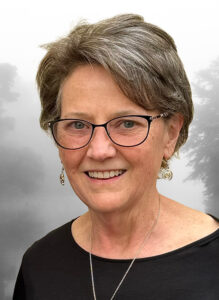 Originally from Austin, Lucy grew up in Kerrville and became interested in photography in 1974 while in high school. Her photography class provided her with a 120mm camera and a basic darkroom setting but it wasn’t long before a local photographer recognized her enthusiasm and talent and loaned her a Nikon F. “His guidance and support were invaluable,” explains Lucy. “The weight of the camera and sound of the shutter seemed natural right away. I wrapped my camera in a bandana, tossed it in my backpack, and pedaled all over Kerrville just enjoying the feel of photographing everything. Always being considered the creative type, photography was an awakening.”
Originally from Austin, Lucy grew up in Kerrville and became interested in photography in 1974 while in high school. Her photography class provided her with a 120mm camera and a basic darkroom setting but it wasn’t long before a local photographer recognized her enthusiasm and talent and loaned her a Nikon F. “His guidance and support were invaluable,” explains Lucy. “The weight of the camera and sound of the shutter seemed natural right away. I wrapped my camera in a bandana, tossed it in my backpack, and pedaled all over Kerrville just enjoying the feel of photographing everything. Always being considered the creative type, photography was an awakening.”
A college trip to New York City in 1979 introduced Lucy to big city architecture and crowds of people unlike anything she had ever seen before. “It made a big impression and I wanted more of that exhilaration. But it would be several more years before I was exposed to that sort of environment again.” In 1981, Lucy graduated with a Bachelor of Arts in Art from Texas State University in San Marcos, Texas. Studying across a variety of mediums and darkroom methods, she began to expand her knowledge of photography even more. Then, as with countless others, working and raising a family suddenly took priority and photographing family life with her new automatic Nikon became the norm… for awhile.
Her transition from Austin back to Kerrville came in 2013 as a new start. “I picked up my first digital camera and began studying Photoshop online. Suddenly, a whole world of creativity rushed in so I set out with my Nikon D3200 exploring everything within driving distance of home. I call these my ‘Town and Country’ days. Photography was empowering and liberating, like another awakening. I wanted to share my newfound enthusiasm and started a business, Blue Bench Studio. From my home studio, I sold prints in galleries, shops, and online and entered local juried exhibits.”
Living in a small town, many of her early subjects were cars and country subjects… anything within driving distance of her home. All of that changed in 2015. “My first trip to Chicago re-opened the big city experience from long ago. Street photography quickly became my favorite subject. The energy and pace were stimulating, and I gravitated toward more industrial and architectural subjects where people just happened to be. The convergence of an angular environment and pulsing humanity is exhilarating to me,” she explains. “I look for contrast, repetition, and structure. Vivian Maier and Robert Frank have been influences in this area. Focusing on kinetic situations means traveling light and extra equipment can be distracting, so I put any optional equipment aside, relying on my Sony A7 as my camera of choice.”
The lights and attractions of big city life eventually extended to Paris, France, where Lucy captured interactions while walking the sidewalks that resulted in some of her most rewarding work. “Paris architecture has its own humanity, especially in Montmartre. The Metro fed my desire for photographing people living in an uncompromising environment and the rigidity of life. That’s not to say that city hopping is my only pursuit. I find subjects everywhere, from the city to my own backyard.”
Then, just as things were going so well, along came COVID, putting the brakes on everything, especially travel, and Lucy has yet to return to the pre-pandemic pace. Motivation and creativity went dormant until summer of 2023 when Lucy was invited to exhibit with a group of artists at the Kerr Arts and Cultural Center. “I accepted the invitation, thinking I had little to contribute. But I needed a push to get out of my slump. Slowly, my brain started thinking in creative terms again, and I began combing through hundreds of files looking for overlooked possibilities. It was cathartic, another awakening. When my photos went up on the gallery walls, I thought ‘This is where my work belongs.’ Although sampling photography online is prevalent, there is something personal about experiencing the printed image in a contemplative space.”
In the world of art, photography is about “the thing itself,” as pointed out by John Szarkowski, late director of photography at NYC’s Museum of Modern Art. So, let’s take a look at some of Lucy’s images and learn about them in her own words.
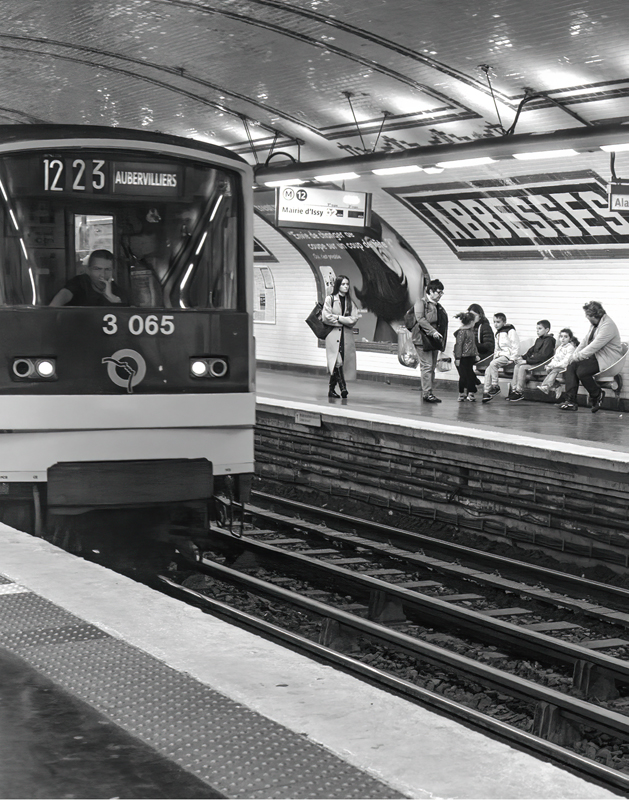 Metro Stop – “We spent a lot of time in Paris deciphering the Metro. I knew right away the Metro was rich with possibilities. While I did get some good photos of trains in motion, I was immediately attracted to this stationary setting. Converging hard lines of the Metro architecture and people waiting contained various demeanors. The group of patient children on the bench were stair-stepped with attentive adults as bookends, keeping the group together. A tense young woman in the middle of the frame with jaw locked and arms folded preferred anonymity. The train conductor lackadaisically holding his chin in his hand looks bored. The focus and noise on this image rendered it unusable until I ran it through Topaz. I wrestled with the cropping. I opted to let the central diagonal track merge with the lower right corner of the frame. This is typical of my style of cropping.”
Metro Stop – “We spent a lot of time in Paris deciphering the Metro. I knew right away the Metro was rich with possibilities. While I did get some good photos of trains in motion, I was immediately attracted to this stationary setting. Converging hard lines of the Metro architecture and people waiting contained various demeanors. The group of patient children on the bench were stair-stepped with attentive adults as bookends, keeping the group together. A tense young woman in the middle of the frame with jaw locked and arms folded preferred anonymity. The train conductor lackadaisically holding his chin in his hand looks bored. The focus and noise on this image rendered it unusable until I ran it through Topaz. I wrestled with the cropping. I opted to let the central diagonal track merge with the lower right corner of the frame. This is typical of my style of cropping.”
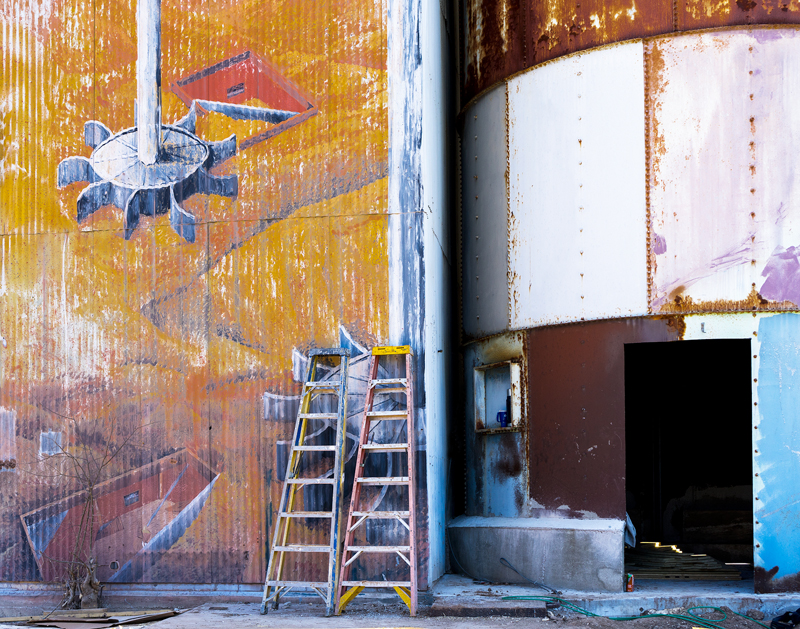
Ladder Pair – “The old grist mill in Johnson City, Texas, has been a fixture for as long as I can remember. It was originally built in the 1880s and closed in the 1980s. I passed by hundreds of times, knowing that it would eventually be torn down or converted. Lots of people have photographed it over the years. In January of 2015 the mill was beginning to stir. Trucks, tools and tradesmen arrived, and a fence was erected. My first thought was that I had missed my opportunity. Wondering what the back of the mill looked like, I quickly pulled over to see what was hidden from the view. In addition to the stately silos, I was drawn to the two ladders neatly standing against the building. The mill had been painted years earlier and the depiction of a gear hung next to the ladders. If you look closely, there is a thermos and cup nearby. This is a good example of my early style developing, focusing on a small part of a whole, looking for seemingly unimportant details.”
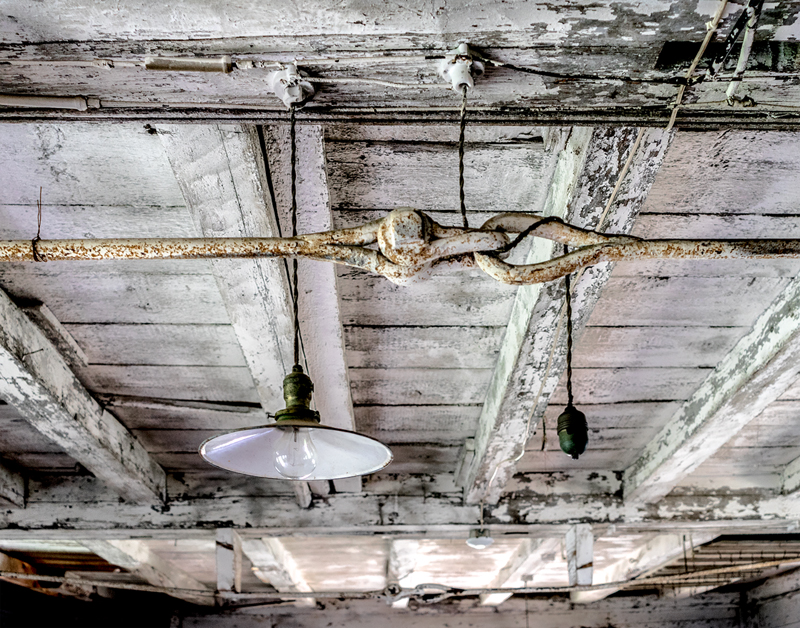
Basement Light – “Canterbury Shaker Village in New Hampshire is a National Landmark. The Shaker architecture and craftsmanship is uncluttered and clean. I was there on a warm clear day in August with hardly anyone else there. The opportunities were many. Descending into a basement I found rafters with a light suspended and an odd gear. The juxtaposition of the lamp and rafters created a unique visual effect. The aging white paint added texture and rust is always interesting. I did not have to do much editing, other than basic sharpening and accentuating the green on the lamp.”
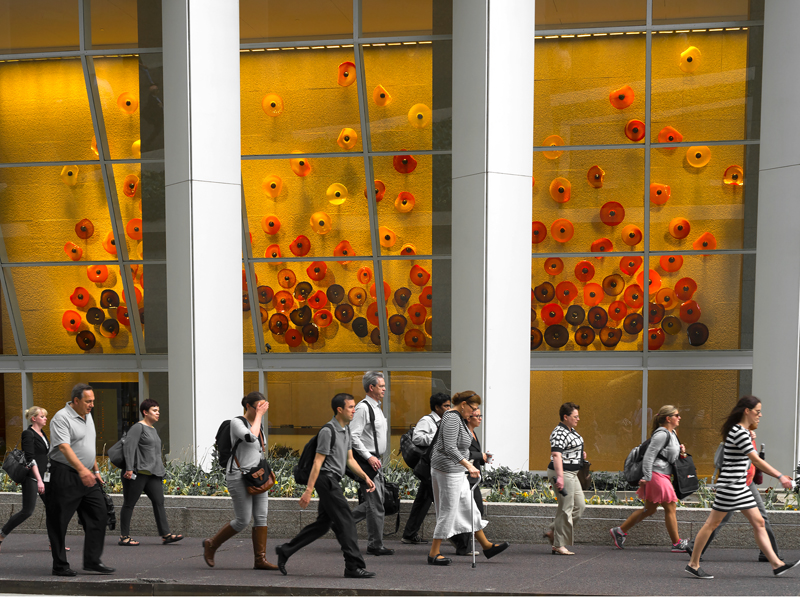
Friday Rush Hour – “The striking orange Chihuly glass art installation in the window of this Chicago office building was the initial attraction to this setting. There was a steady flow of rush hour pedestrians striding past the splash of color, everyone was in a hurry. The traffic was thick, so I took many exposures between red lights knowing at least one would produce what I wanted. Upon review, there were plenty. The photograph I settled on had one lady shielding her face from my probing lens. The busyness of the glass art was congruous with the pace of the people. I am adamant that I do not take pictures of another artist’s work for any other reason than my own reference. However, with the pedestrian traffic and building structure as a major part of the composition, I felt all the elements were there to consider it my own. I played with color mixing to accentuate the orange and make the people black and white, but it left the people flat. In the end, I left some colored clothing. In the final product, the orange disks looked like numerous eyes overlooking the Friday flow.”
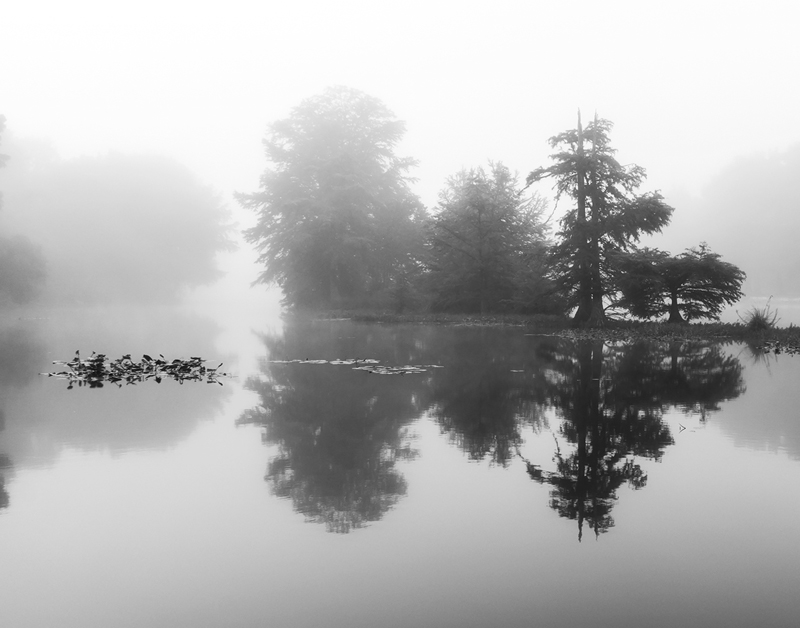
Foggy River – “One morning I woke up at dawn to a thick fog. I raced to a low water crossing on the Guadalupe River in Kerrville. There was also a fisherman a few paces from me, with his thermos, tackle box and camp chair. We said ‘hello’ but spent the next hour in silence, absorbing the peacefulness. He moved along and I was left, still engrossed by the rolling fog and rising sun. I took a couple of hundred photographs over the next 3 hours. Interestingly, what I envisioned in my mind was black and white. In reality, there was a green cast. This is a great example of the difference between what you see and what the camera sees. Reviewing the download at home, I got to relive the experience, which I hold dear. I grew up near the Guadalupe River. The river and especially the Cypress trees are part of my soul. It’s where I go to rejuvenate and clear my head.”
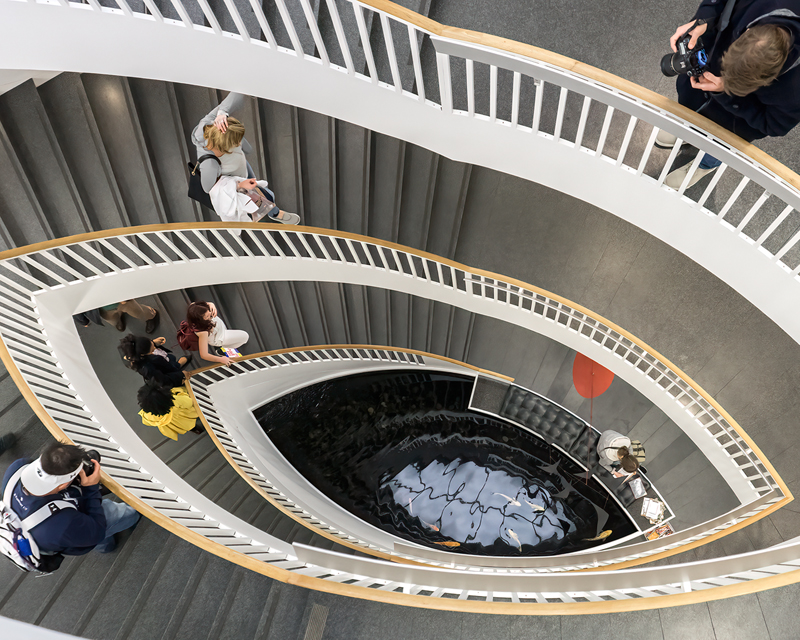
Museum Staircase – “Of all the things I love about Chicago, the art museums are my favorite. This helix staircase in the Museum of Contemporary Art offers almost unlimited possibilities. You can stand on any level, looking up or down, and see the interplay of lines and negative space. At the bottom of the stairwell is a sometimes pond. I have also seen it with a crochet net. The next time I’m there, who knows! On this visit when I looked down the inside of the stairwell, I was able to capture another photographer echoing the same inspiration.”
When Lucy Jennings first began exhibiting her work, she overheard observers and other artists in galleries comment that photography is questionable as an art form. Some people think that all you do is click the shutter and there is no real artistic ability in that. My reply to them is that my lifelong learning and perpetual consideration of color, form, contrast and light is more than a click of a shutter. The click of the shutter is a crucial component, but it is a fraction of the creative process.”
Lucy’s future plans include exploring still life photography and photo transfers with encaustic medium. “I still have hundreds of images to resurrect through editing and many more to take. There is no straight line in my journey. Evolving as an artist, I feel the pull to get out of my comfort zone.”
Since the early 19th century, photography has led to some profound changes in the way artwork is produced. Photographic art is photography that has been done specifically for creative expression and not for a commercial brief. The appeal of these photographs to people make them rare and collectible, just like other forms of artwork.
Many photographers seek this recognition, but few actually achieve it. We’ve found one in particular from a small Texas town situated along the banks of the Guadalupe River who has managed to find a place in such a world.
So, the next time you find yourself in Kerrville, Texas, look around and chances are that you will see some of Lucy’s work. It’s a small town, and you will most likely meet someone there who knows Lucy and her photographic artwork. You can also check her website at www.bluebenchstudio.com.



